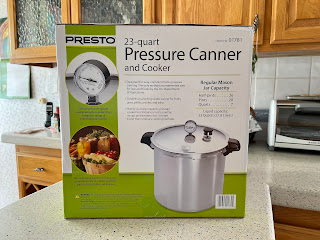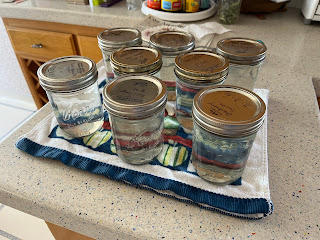The boneless-skinless chicken in my freezer was part of what put me over the edge. If I didn't have to cook it up before having it to use in lunches and casseroles, I would eat it a lot more and not let it languish in the deep freeze. I would use canned meats far more if I could control the salt and spices in them and they didn't cost so much to replace. I also miss having canned soups, but very few fit my current eating lifestyle and all of them have too much salt.
It also does more than just pressure can jars. It's a pressure cooker, if I ever want to cook up 10 lbs of pork butt for a luau or an entire brisket. I could use it to make the broth that I will later be canning. It's a giant stock pot and can be used as a steamer. With the extra racks I ordered, I could make three layers of tamales and feed everyone I know.
I spent a week doing a cost/benefit analysis. Not everything is cheaper home-canned. There's the price of the ingredients plus 40¢ or so for the lid. (I did combine a sale and a gift card to order lids for what ended up being 14¢ apiece for a couple of years' worth.) Just because some things are can-able doesn't mean I like them that way, like green beans and peas. There's the initial cost outlay for jars and equipment, some of which I already have from water bath canning. I'm estimating a 2-year break even point, which is far sooner than I had originally expected. A lot of that is in broth, which is basically just the cost of the lid because the rest of it is stuff you throw away, like bones and veggie trimmings. A well-maintained canner and jars can last nearly forever, so these are one-time purchases.
What made me go for it right now was a really good sale combined with far more Amazon rewards than I realized I had from my credit card. It wasn't free, but it was pretty close.This blog is not going to become all about canning. I'm not starting a new chapter. I will share my experiences just as I would any recipe I'm trying for the first time, then move on. I don't post every time I water-bath can, only when the recipe is interesting and not a repeat. I only expect to can about once a month anyway. Seriously, a 9-pint load of anything will last me quite some time, and you really shouldn't put up more than a year's worth of any one item, same as water bath canning. I will still refer to a "can" of something as a grocery store item, as a can of tomatoes or beans is the same yield as a pint jar.
The first step was reading the manual a few times and running a load of water only up to 15 pounds of pressure to find out if the dial gauge is accurate. It isn't part of the instructions, but it should be. The factory 15-pound jiggler, to be used for pressure cooking, starts to rock at 14 on the dial, so I know that the gauge is one pound low. Canning at sea level is 10-11 pounds, and I now know to err closer to 10 until I buy a 10-pound weight. No idea why canners don't come with them. I think ForJars is the only brand that comes with multiple weights for different elevations.



No comments:
Post a Comment
I got tired of having to moderate all the spam comments and put back the verification. Sorry if it causes hassles.